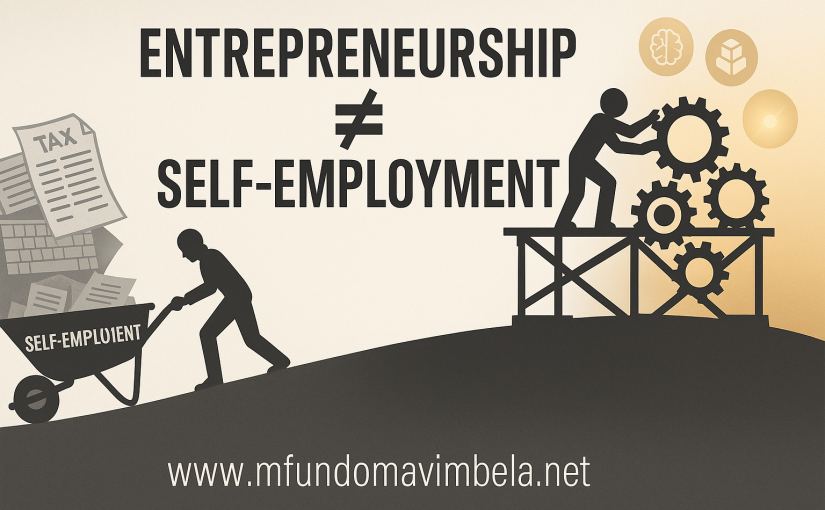For years, we’ve been sold a story: start your own business, be your own boss, achieve financial freedom. It’s a story repeated at workshops, in glossy brochures, and by motivational speakers who make a living selling the dream. But after two decades of building, winning, stumbling, and rebuilding, I can tell you this: what most people call entrepreneurship is not entrepreneurship at all. It’s self-employment. And the two are very different.
The Illusion of Financial Freedom
When people talk about entrepreneurship, they often mean self-employment: opening a small business, freelancing, hustling to pay the bills. That’s valid work, but let’s not confuse it with true entrepreneurship. Self-employment can give you independence, but it often traps you in endless work, thin margins, and constant compliance battles.
In countries like ours, the system makes this worse. Taxes pile up. Access to credit is almost impossible. Compliance costs eat away at your revenue until you’re forced to cut corners. Many SMEs don’t fail because their founders are lazy or incompetent—they fail because the environment punishes them for trying.
Meanwhile, the narrative of “financial freedom” is dangled in front of you like a carrot. But financial freedom doesn’t come from self-employment. If anything, it can chain you tighter.
What Real Entrepreneurship Looks Like
True entrepreneurship is different. It’s not about creating a job for yourself. It’s about building systems, assets, and organizations that can live beyond you. Entrepreneurs don’t just own a business; they design a machine that creates value at scale.
Self-employment says: I work for myself.
Entrepreneurship says: I build something that works even without me.
That difference is massive. The self-employed are limited by their own time and energy. Entrepreneurs multiply their impact through people, processes, and products that grow larger than their personal effort.
One of the books that helped me see this distinction—beyond my own experience—was Robert Kiyosaki’s Cashflow Quadrant. Kiyosaki explains the difference between being an Employee (E), Self-Employed (S), Business Owner (B), and Investor (I). Most of us are stuck in the “S” quadrant—working harder and harder for ourselves—but never crossing into “B,” where systems and people work for you. That framework clarified for me why so many SMEs get trapped and why so few make the leap to true entrepreneurship.
Why the Distinction Matters
I’ve succeeded at times and failed at others. I’ve made money, and I’ve lost more than I thought I could. I’ve seen corporate classmates climb the ladder with stability and security while I wrestled with tenders, compliance, and tax burdens. And through it all, I’ve come to one clear conclusion: the language around entrepreneurship has misled us.
If we keep confusing self-employment with entrepreneurship, we will keep producing more disillusioned founders, trapped in survival mode and wondering why the “freedom” never comes.
We need honesty. We need to separate the two. We need to stop pretending that registering a business is the same as building an enterprise. And we need to build systems in this country that actually allow entrepreneurs to thrive—because when true entrepreneurship wins, society wins.
Three Steps to Move from Self-Employment to Entrepreneurship
If you’ve recognized yourself in the “self-employed” trap, don’t despair. You can start shifting toward true entrepreneurship. It won’t be easy, but it is possible:
1. Build Systems, Not Just Income
Ask yourself: can this business run without me for a month? If the answer is no, then you’re not yet an entrepreneur—you’re self-employed. Start documenting processes, training others, and creating systems that make your business less dependent on you.
2. Leverage People and Partnerships
You can’t scale alone. Entrepreneurs multiply their impact through teams, collaborators, and networks. Hire, delegate, and form partnerships that expand your reach and create new revenue streams beyond your direct labor.
3. Focus on Assets, Not Just Hustle
Assets—brands, intellectual property, technology, distribution networks—are what separate the entrepreneur from the self-employed. Hustle pays the bills, but assets create long-term wealth. Start asking: what am I building today that will still generate value tomorrow, even if I’m not working?
Final Word
If you’re self-employed, don’t be ashamed of it. But know what it is. Don’t let anyone sell you the lie that it guarantees wealth or freedom. And if you’re serious about entrepreneurship, prepare yourself for something much harder, much riskier, but also potentially much more rewarding.
After 20 years, here’s what I know: self-employment feeds you. Entrepreneurship changes the game. And until we stop confusing the two, we’ll keep lying to ourselves.
